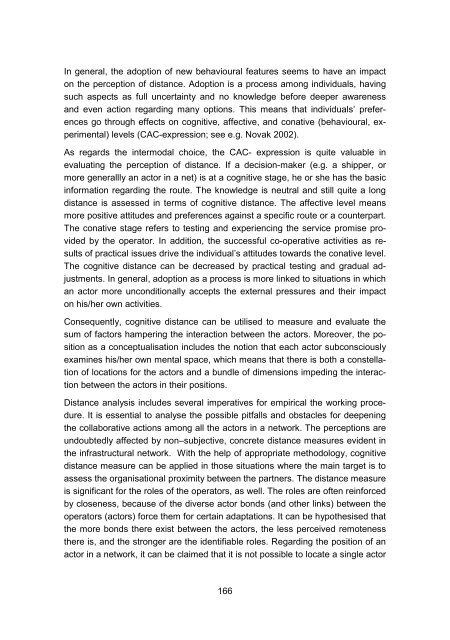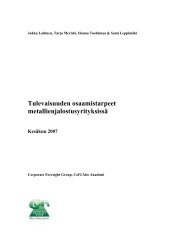849954 sisus
849954 sisus
849954 sisus
Create successful ePaper yourself
Turn your PDF publications into a flip-book with our unique Google optimized e-Paper software.
In general, the adoption of new behavioural features seems to have an impact<br />
on the perception of distance. Adoption is a process among individuals, having<br />
such aspects as full uncertainty and no knowledge before deeper awareness<br />
and even action regarding many options. This means that individuals’ preferences<br />
go through effects on cognitive, affective, and conative (behavioural, experimental)<br />
levels (CAC-expression; see e.g. Novak 2002).<br />
As regards the intermodal choice, the CAC- expression is quite valuable in<br />
evaluating the perception of distance. If a decision-maker (e.g. a shipper, or<br />
more generallly an actor in a net) is at a cognitive stage, he or she has the basic<br />
information regarding the route. The knowledge is neutral and still quite a long<br />
distance is assessed in terms of cognitive distance. The affective level means<br />
more positive attitudes and preferences against a specific route or a counterpart.<br />
The conative stage refers to testing and experiencing the service promise provided<br />
by the operator. In addition, the successful co-operative activities as results<br />
of practical issues drive the individual’s attitudes towards the conative level.<br />
The cognitive distance can be decreased by practical testing and gradual adjustments.<br />
In general, adoption as a process is more linked to situations in which<br />
an actor more unconditionally accepts the external pressures and their impact<br />
on his/her own activities.<br />
Consequently, cognitive distance can be utilised to measure and evaluate the<br />
sum of factors hampering the interaction between the actors. Moreover, the position<br />
as a conceptualisation includes the notion that each actor subconsciously<br />
examines his/her own mental space, which means that there is both a constellation<br />
of locations for the actors and a bundle of dimensions impeding the interaction<br />
between the actors in their positions.<br />
Distance analysis includes several imperatives for empirical the working procedure.<br />
It is essential to analyse the possible pitfalls and obstacles for deepening<br />
the collaborative actions among all the actors in a network. The perceptions are<br />
undoubtedly affected by non–subjective, concrete distance measures evident in<br />
the infrastructural network. With the help of appropriate methodology, cognitive<br />
distance measure can be applied in those situations where the main target is to<br />
assess the organisational proximity between the partners. The distance measure<br />
is significant for the roles of the operators, as well. The roles are often reinforced<br />
by closeness, because of the diverse actor bonds (and other links) between the<br />
operators (actors) force them for certain adaptations. It can be hypothesised that<br />
the more bonds there exist between the actors, the less perceived remoteness<br />
there is, and the stronger are the identifiable roles. Regarding the position of an<br />
actor in a network, it can be claimed that it is not possible to locate a single actor<br />
166








